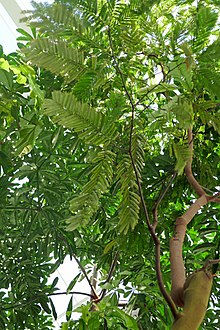Piptadeniastrum africanum
| Piptadeniastrum africanum | |
|---|---|

| |
| Scientific classification | |
| Kingdom: | |
| (unranked): | Angiosperms
|
| (unranked): | |
| (unranked): | |
| Order: | |
| Family: | |
| Genus: | |
| Species: | P. africanum
|
| Binomial name | |
| Piptadeniastrum africanum (Hook.f.) Brenan
| |
Piptadeniastrum africanum is a tall deciduous tree within the Fabaceae family, its timber is traded under the names, Dabema or Dahoma.[1] It commonly occurs in freshwater swamp forests but can also be found further north.
Description[]
The species is a medium-sized to large tree capable of growing to 50 meters tall, it has wide spreading branches. Its trunk is straight and cylindrical [2] while the base of the tree has thin buttress roots that can reach a height of 5 meters or more and extends along the ground, its bark is grey to brown in color but reddish at the base.[3] Leaves are alternate, bipinnately compound in arrangement with about 10 - 20 pairs of pinnae and about 30 - 58 leaflets per each pinnae.[1] Leaflets, sessile and small, 0.3 x 1 cm long and 0.8 x 1.25 mm wide, glossy green above and paler beneath. Flower is yellowish to white colored and fruit is a brown woody pod, .[3]
Distribution[]
Naturally occurs in the rain forest zones of West and Central Africa from Senegal to Sudan and moving southwards towards Northern Angola. It is locally known as Dabema in Ivory Coast and as Dahoma in Ghana.[4]
Chemistry[]
Methanol and aqueous extracts from the stem bark tested for the presence of flavonoids, phenols, tannins and saponins.[5] Profiles of its compounds include a variety of dihydroxy-trimethoxy(iso)flavone isomers, apigenin, chrysoeriol, eriodictyol, luteolin, and liquiritigenin.[5]
Uses[]
The chemical compounds of Piptadeniastrum africanum has generated interest among researchers largely because of a wide variety of afflictions plant extracts are used to treat in traditional medicine.[6] Extracts of the species in used to treat gastric ulcers, the Baka people of Cameroon use macerated stem bark extracts in preparations to treat abdominal pains.[6] While some healers use leave extracts as a tonic or as an aphrodisiac.[6] In Congo and Ghana, it is applied in native medicine as a treatment for back pains and sexual asthenia.[6]
Its timber is valued for use in building canoes and in marine and bridge construction.[1]
References[]
- ^ a b c Lemmens, Rudolphe (2020). Useful trees of East Africa. Paris: BoD-Books on demand. p. 257. ISBN 978-2-322-21072-5. OCLC 1245191115.
- ^ Allen, O. N. (1981). The Leguminosae, a source book of characteristics, uses, and nodulation. Ethel K. Allen. Madison, Wisc.: University of Wisconsin Press. p. 523. ISBN 0-299-08400-0. OCLC 7175396.
- ^ a b Neuwinger, Hans Dieter (1996). African ethnobotany : poisons and drugs : chemistry, pharmacology, toxicology. London: Chapman & Hall. p. 655. ISBN 3-8261-0077-8. OCLC 34675903.
- ^ "Piptadeniastrum africanum". www.fpl.fs.fed.us. Retrieved 2021-08-06.
- ^ a b Sinan, Kouadio Ibrahime; Chiavaroli, Annalisa; Orlando, Giustino; Bene, Kouadio; Zengin, Gokhan; Cziáky, Zoltán; Jekő, József; Fawzi Mahomoodally, Mohamad; Picot-Allain, Marie Carene Nancy; Menghini, Luigi; Recinella, Lucia (2020-03-28). "Evaluation of Pharmacological and Phytochemical Profiles of Piptadeniastrum africanum (Hook.f.) Brenan Stem Bark Extracts". Biomolecules. 10 (4): 516. doi:10.3390/biom10040516. ISSN 2218-273X. PMC 7226170. PMID 32231150.
- ^ a b c d Dlamini, Lindiwe M.; Tata, Charlotte M.; Djuidje, Marthe Carine F.; Ikhile, Monisola I.; Nikolova, Galina D.; Karamalakova, Yana D.; Gadjeva, Veselina G.; Zheleva, Antoanetta M.; Njobeh, Patrick B.; Ndinteh, Derek T. (2019). "Antioxidant and prooxidant effects of Piptadeniastrum africanum as the possible rationale behind its broad scale application in African ethnomedicine". Journal of Ethnopharmacology. 231: 429–437. doi:10.1016/j.jep.2018.11.039. PMID 30503766.
- Flora of West Tropical Africa
- Flora of the Democratic Republic of the Congo
- Mimosoids